The bar is taken - the new from Seagate for storage
Hard drives today are almost completely gone from the market of household computers, but in the professional environment, the complete crowding out of HDDs with solid-state drives is still a vague prospect. There are several reasons for this: the small capacity of SSDs, their limited resource and high cost. It is not surprising that the leading manufacturers of hard drives today focused on the professional market, or rather, on the storage industry. And although the technologies used in hard drives have already been studied along and across, and the storage density has approached the theoretical limit, setting records is still possible. We tried very hard - and took the next bar in the 3.5-inch form factor with the new Seagate 16 TB drive.

IT sectors gaining momentum associated with operating with large volumes of data require more and more space for storing information. But assembling arrays exclusively from solid state drives is expensive. Therefore, a couple of years ago, leading storage vendors began to actively sell hybrid storage, where hard drives and SSDs coexist perfectly within the array. This allows you to create a large storage space with quick access to hot data. So, as you can see, the HDD market is still far from sunset.
Seagate, as a world-renowned manufacturer of hard drives, was one of the originators of this trend: if it is not the “dad” of the hard drive (IBM can be called one), then it is definitely the “native uncle”. From the very beginning of working with HDD, Seagate was seriously invested in R&D, therefore it is our company that owns the lion's share of records. Here is the latest news: on June 16, 2019 in Cupertino (California) we introduced a new product - a 16 terabyte professional hard drive.
Below are the main technical specifications of the new product (16 TB version):
→ Full specifications on the manufacturer’s website | Datasheet to PDF
Engineers tried to make maximum use of the internal space of the drive, so it weighs only 680 grams - less than 14 TB models. A wide weld seam runs along the end of the disk - this is a guarantee of reliable retention of helium inside. For the same reason - due to the lack of screws and a sloping cover - the Exos 16 looks more aesthetically pleasing.
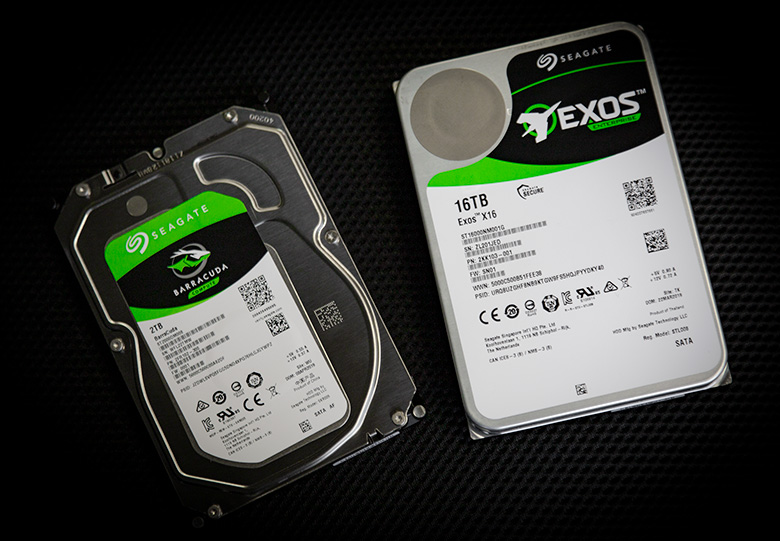
True, because of this same feature, the disk cannot be disassembled - which can be a minus when trying to restore data in specialized workshops. To avoid this kind of quest, here are universal tips: do not forget to make backups in time, create redundant disk arrays and use the drive in normal conditions.
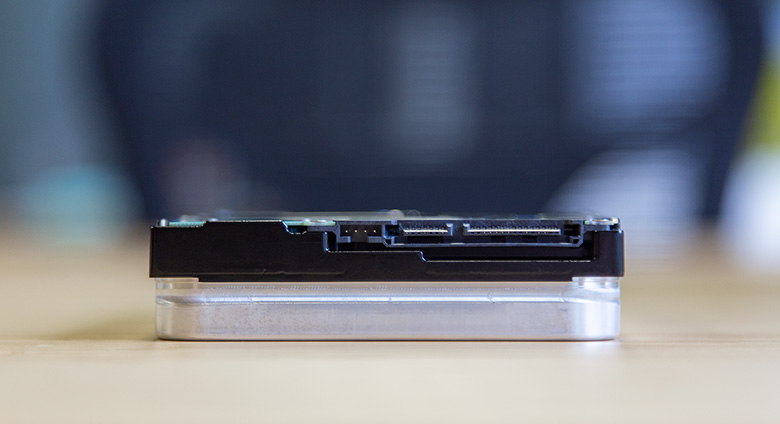
The controller board also follows the trend for compactness: it is a strip two centimeters wide. On the top cover is a sticker in the "toy" style (like all modern drives from Seagate), where all the necessary information about the model is indicated. At the end opposite the contact group, there is also a sticker with a serial number so that the disk can be easily found in a pile.

Like all large-capacity drives, Exos 16 uses the technology of the helium environment of the hermetic zone. This gives tangible advantages - density and overall reliability of the drive. The effective use of helium in the drive’s hermetic blocks began several years ago when methods were developed to reliably hold such a volatile substance as helium inside. The molecules of this inert gas are very small, which makes it extremely fluid. Due to this, the helium medium, unlike the classical air, reduces flow swirls, turbulence and other special effects during operation, which increases the stability of the positioning of the drive mechanics. This means that you can compose such drives more tightly.
The new 16-terabyte Seagate Exos X16 is positioned as a drive for high-density disk storage, combining high speed and record volume for an adequate price.
Today, this disk model has a high spindle speed of 7200 rpm for the LFF form factor (3.5 "). It is designed for both OEMs and end-users. However, no one bothers to purchase Exos 16 for at home: in fact, this is a regular SATA-drive, compatible with absolutely all modern computers, where you can insert a 3.5-inch drive - no enterprise grade interfaces and other obstacles.Moreover, compared to similar consumer models, this drive has increased reliability, has an operating time on failure at 24x7 operation mode, it has a more efficient cache and stable operation speed.Although professional drives are noisier than home drives, this drive has become much quieter compared to 10-terabyte Seagate two years ago, and its heating during operation does not go beyond The only thing you need to keep in mind when installing the drive is that it (like all “fat men”) has a different arrangement of mounting holes from the bottom of the case, which limits its reliable installation in some types of baskets and NAS.
Measurements of performance were carried out on a modern chipset with a SATA-3 interface and an 8-core processor from Intel running Windows 10 Pro. We used the latest version of the well-established HD Tune Pro utility with default settings. There was an idea to take measurements on server hardware, but then the results would not be indicative, since the SATA-3 interfaces of consumer and server platforms are almost the same. It is worth noting that Exos 16 has a SAS version operating at a linear interface speed of 12 GB / s, but the story about it is beyond the scope of our review.
To a public spoiled by the characteristics of SSDs, the test results may seem modest, but we remind you that the hero of our review is the HDD, designed for a specific area of application: primarily in storage. Here are the results in numbers: linear reading - from 115 to 271 MB / s with an average value of 208 MB / s, writing - from 113 to 269 MB / s with an average value of 208 MB / s. The average access time is 11.5 ms for reading and 5.8 ms for writing.

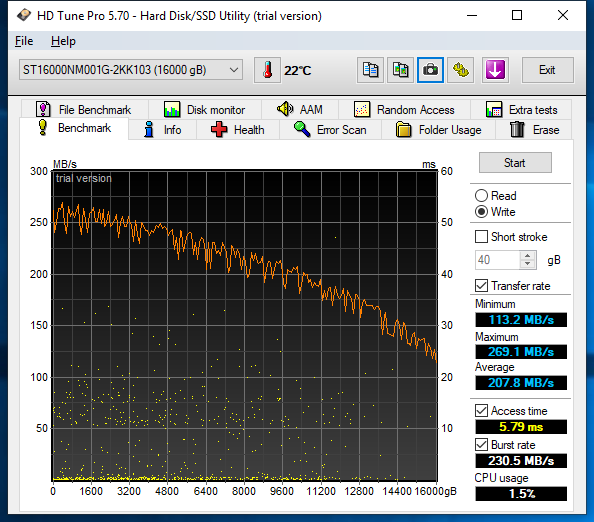
The random access time is within 12-14 ms for reading and tenths of milliseconds for writing thanks to a separate cache. This is a good result.
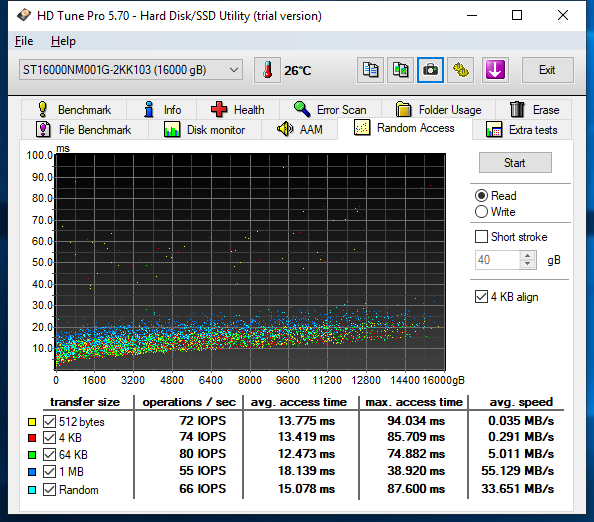

Additional read and write test results:
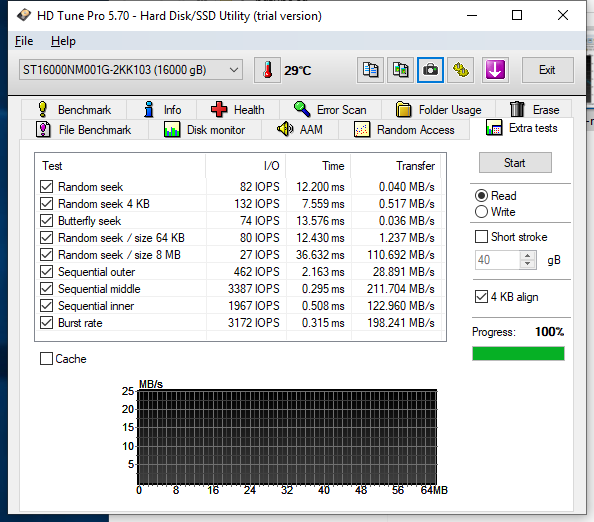

The new Exos will be an excellent choice for storage, and especially for the growing SDS solutions based on cheap white-label server platforms. In the context of the struggle for the price of each gigabyte, an array of such disks will be a good help, because its recommended retail price is $ 629.
If we talk about home use, then the disk is perfect for owners of NAS NAS or for users with large home archives (RAW-photographers, musicians, videographers) - 16 TB is enough for a long time.
But where it is not worth using the drive, it’s in the conditions of shaking: its “stuffing” is quite tender, and losing so much data will be unpleasant. In such cases, use low-cost, low-density drives, or better yet, SSDs. And do not forget to backup!

IT sectors gaining momentum associated with operating with large volumes of data require more and more space for storing information. But assembling arrays exclusively from solid state drives is expensive. Therefore, a couple of years ago, leading storage vendors began to actively sell hybrid storage, where hard drives and SSDs coexist perfectly within the array. This allows you to create a large storage space with quick access to hot data. So, as you can see, the HDD market is still far from sunset.
Seagate, as a world-renowned manufacturer of hard drives, was one of the originators of this trend: if it is not the “dad” of the hard drive (IBM can be called one), then it is definitely the “native uncle”. From the very beginning of working with HDD, Seagate was seriously invested in R&D, therefore it is our company that owns the lion's share of records. Here is the latest news: on June 16, 2019 in Cupertino (California) we introduced a new product - a 16 terabyte professional hard drive.
Technical specifications Seagate Exos X16
Below are the main technical specifications of the new product (16 TB version):
| Model | Seagate ST16000NM001G |
| Interface | SATA 6 GB / s |
| Storage capacity | 16 TB |
| Spindle speed | 7200 rpm |
| Cache size | 256 MB |
| Height | 26.1 mm |
| MTBF | 2,500,000 hours |
| Max. constant outer diameter data transfer rate | 261 MB / s, 249 MiB / s |
| Random Read / Write 4K QD16 WCD (I / O operations per second) | 170 IOPS / 440 IOPS |
| Average delay | 4.16 ms |
→ Full specifications on the manufacturer’s website | Datasheet to PDF
Appearance
Engineers tried to make maximum use of the internal space of the drive, so it weighs only 680 grams - less than 14 TB models. A wide weld seam runs along the end of the disk - this is a guarantee of reliable retention of helium inside. For the same reason - due to the lack of screws and a sloping cover - the Exos 16 looks more aesthetically pleasing.

True, because of this same feature, the disk cannot be disassembled - which can be a minus when trying to restore data in specialized workshops. To avoid this kind of quest, here are universal tips: do not forget to make backups in time, create redundant disk arrays and use the drive in normal conditions.

The controller board also follows the trend for compactness: it is a strip two centimeters wide. On the top cover is a sticker in the "toy" style (like all modern drives from Seagate), where all the necessary information about the model is indicated. At the end opposite the contact group, there is also a sticker with a serial number so that the disk can be easily found in a pile.

Like all large-capacity drives, Exos 16 uses the technology of the helium environment of the hermetic zone. This gives tangible advantages - density and overall reliability of the drive. The effective use of helium in the drive’s hermetic blocks began several years ago when methods were developed to reliably hold such a volatile substance as helium inside. The molecules of this inert gas are very small, which makes it extremely fluid. Due to this, the helium medium, unlike the classical air, reduces flow swirls, turbulence and other special effects during operation, which increases the stability of the positioning of the drive mechanics. This means that you can compose such drives more tightly.
The new 16-terabyte Seagate Exos X16 is positioned as a drive for high-density disk storage, combining high speed and record volume for an adequate price.
Today, this disk model has a high spindle speed of 7200 rpm for the LFF form factor (3.5 "). It is designed for both OEMs and end-users. However, no one bothers to purchase Exos 16 for at home: in fact, this is a regular SATA-drive, compatible with absolutely all modern computers, where you can insert a 3.5-inch drive - no enterprise grade interfaces and other obstacles.Moreover, compared to similar consumer models, this drive has increased reliability, has an operating time on failure at 24x7 operation mode, it has a more efficient cache and stable operation speed.Although professional drives are noisier than home drives, this drive has become much quieter compared to 10-terabyte Seagate two years ago, and its heating during operation does not go beyond The only thing you need to keep in mind when installing the drive is that it (like all “fat men”) has a different arrangement of mounting holes from the bottom of the case, which limits its reliable installation in some types of baskets and NAS.
Seagate Exos X16 Drive Speed Measurements
Measurements of performance were carried out on a modern chipset with a SATA-3 interface and an 8-core processor from Intel running Windows 10 Pro. We used the latest version of the well-established HD Tune Pro utility with default settings. There was an idea to take measurements on server hardware, but then the results would not be indicative, since the SATA-3 interfaces of consumer and server platforms are almost the same. It is worth noting that Exos 16 has a SAS version operating at a linear interface speed of 12 GB / s, but the story about it is beyond the scope of our review.
To a public spoiled by the characteristics of SSDs, the test results may seem modest, but we remind you that the hero of our review is the HDD, designed for a specific area of application: primarily in storage. Here are the results in numbers: linear reading - from 115 to 271 MB / s with an average value of 208 MB / s, writing - from 113 to 269 MB / s with an average value of 208 MB / s. The average access time is 11.5 ms for reading and 5.8 ms for writing.


The random access time is within 12-14 ms for reading and tenths of milliseconds for writing thanks to a separate cache. This is a good result.


Additional read and write test results:


Instead of output
The new Exos will be an excellent choice for storage, and especially for the growing SDS solutions based on cheap white-label server platforms. In the context of the struggle for the price of each gigabyte, an array of such disks will be a good help, because its recommended retail price is $ 629.
If we talk about home use, then the disk is perfect for owners of NAS NAS or for users with large home archives (RAW-photographers, musicians, videographers) - 16 TB is enough for a long time.
But where it is not worth using the drive, it’s in the conditions of shaking: its “stuffing” is quite tender, and losing so much data will be unpleasant. In such cases, use low-cost, low-density drives, or better yet, SSDs. And do not forget to backup!
All Articles